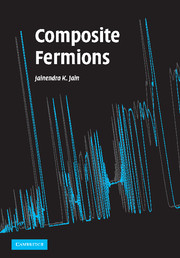Book contents
- Frontmatter
- Contents
- Preface
- List of symbols and abbreviations
- 1 Overview
- 2 Quantum Hall effect
- 3 Landau levels
- 4 Theory of the IQHE
- 5 Foundations of the composite fermion theory
- 6 Microscopic verifications
- 7 Theory of the FQHE
- 8 Incompressible ground states and their excitations
- 9 Topology and quantizations
- 10 Composite fermion Fermi sea
- 11 Composite fermions with spin
- 12 Non-composite fermion approaches
- 13 Bilayer FQHE
- 14 Edge physics
- 15 Composite fermion crystals
- Appendixes
- References
- Index
9 - Topology and quantizations
Published online by Cambridge University Press: 07 December 2009
- Frontmatter
- Contents
- Preface
- List of symbols and abbreviations
- 1 Overview
- 2 Quantum Hall effect
- 3 Landau levels
- 4 Theory of the IQHE
- 5 Foundations of the composite fermion theory
- 6 Microscopic verifications
- 7 Theory of the FQHE
- 8 Incompressible ground states and their excitations
- 9 Topology and quantizations
- 10 Composite fermion Fermi sea
- 11 Composite fermions with spin
- 12 Non-composite fermion approaches
- 13 Bilayer FQHE
- 14 Edge physics
- 15 Composite fermion crystals
- Appendixes
- References
- Index
Summary
Topology is the study of properties of geometric configurations that remain invariant under continuous deformations. It is of relevance in graph theory, network theory, and knot theory. Many physical phenomena have topological content. Perhaps the best known is the Aharonov–Bohm phase for a closed path of a charged particle around a localized magnetic flux, which is independent of the shape and the length of the path so long as it is outside the region containing the magnetic flux. It is a special case of a more general concept, known as the Berry phase. The latter is the phase acquired when the parameters of a Hamiltonian execute a closed loop in the parameter space; the Berry phase does not depend on the rate at which the loop is executed, provided it is sufficiently slow. (There is no speed limit for the Aharonov–Bohm phase. In this case the adiabatic approximation of Berry becomes exact.)
The most dramatic examples of topology lead to macroscopic quantizations, such as the quantization of flux (in units of h/2e; 2e because of pairing) through a superconducting loop or through a vortex in a type-II superconductor. The quantization of flux results from the topological property that the phase of the order parameter can only change by an integral number times 2π around the flux.
Topology enters into the physics of the fractional quantum Hall effect through the formation of composite fermions, one constituent of which, namely the vortex, is topological.
- Type
- Chapter
- Information
- Composite Fermions , pp. 253 - 285Publisher: Cambridge University PressPrint publication year: 2007

